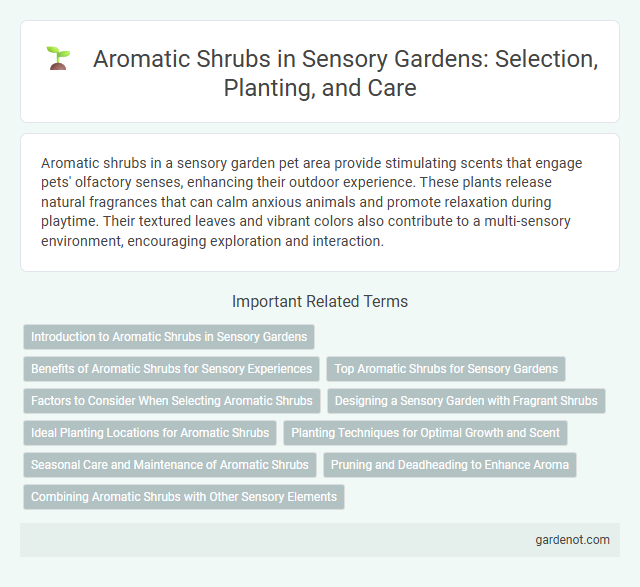Aromatic shrubs in a sensory garden pet area provide stimulating scents that engage pets' olfactory senses, enhancing their outdoor experience. These plants release natural fragrances that can calm anxious animals and promote relaxation during playtime. Their textured leaves and vibrant colors also contribute to a multi-sensory environment, encouraging exploration and interaction.
Introduction to Aromatic Shrubs in Sensory Gardens
Aromatic shrubs, such as lavender, rosemary, and sage, play a crucial role in sensory gardens by stimulating the sense of smell with their distinctive fragrances. These plants are carefully selected for their strong, pleasant aromas that enhance the therapeutic and sensory experience of the garden environment. Incorporating aromatic shrubs promotes relaxation, sensory engagement, and a deeper connection to nature through olfactory stimulation.
Benefits of Aromatic Shrubs for Sensory Experiences
Aromatic shrubs enrich sensory gardens with their fragrant foliage and flowers, stimulating the olfactory senses and enhancing emotional well-being. These plants, such as lavender, rosemary, and thyme, release essential oils that can reduce stress and improve mood while offering tactile experiences through varied leaf textures. Their presence supports therapeutic activities and creates immersive environments that engage multiple senses simultaneously.
Top Aromatic Shrubs for Sensory Gardens
Top aromatic shrubs for sensory gardens include lavender, rosemary, and thyme, valued for their fragrant leaves and flowers that stimulate the sense of smell. These shrubs not only provide delightful scents but also attract pollinators such as bees and butterflies, enhancing biodiversity. Their drought tolerance and ease of maintenance make them ideal choices for creating multi-sensory outdoor spaces.
Factors to Consider When Selecting Aromatic Shrubs
Selecting aromatic shrubs for a sensory garden requires evaluation of factors such as climate compatibility, soil type, and sunlight exposure to ensure optimal growth and fragrance release. Consider the shrub's scent intensity and seasonality to maintain year-round sensory stimulation. Additionally, choose species with low allergenic potential and minimal maintenance needs to enhance visitor comfort and garden sustainability.
Designing a Sensory Garden with Fragrant Shrubs
Fragrant shrubs such as lavender, rosemary, and jasmine play a vital role in designing a sensory garden by offering rich, aromatic experiences that engage the olfactory senses. These aromatic shrubs thrive in well-drained soil and full sunlight, making them ideal for creating inviting garden pathways or sensory zones. Incorporating a variety of scented shrubs enhances biodiversity and stimulates memory recall and relaxation through their distinct natural fragrances.
Ideal Planting Locations for Aromatic Shrubs
Aromatic shrubs thrive in well-drained soil with full sun to partial shade, making garden edges, borders, and pathways ideal planting locations to enhance sensory experiences. Positioning these shrubs near seating areas or walkways allows their fragrant foliage and flowers to be easily appreciated. Avoid overly shaded or waterlogged areas to ensure robust growth and maximize aroma release.
Planting Techniques for Optimal Growth and Scent
Aromatic shrubs thrive when planted in well-drained soil with ample sunlight, ensuring maximum essential oil production for potent fragrances. Pruning techniques involve cutting back old growth to stimulate new shoots, enhancing both plant vitality and scent intensity. Proper spacing between shrubs increases air circulation, reducing disease risk and promoting healthier, more aromatic foliage.
Seasonal Care and Maintenance of Aromatic Shrubs
Aromatic shrubs require diligent seasonal care to maintain their fragrance and health, including regular pruning in late winter to encourage new growth and prevent overgrowth of woody stems. Mulching around the base during colder months helps protect the roots from frost damage, while spring fertilization with a balanced, slow-release fertilizer enhances aromatic oil production. Consistent watering during dry spells and ensuring well-drained soil reduces stress on the shrubs, promoting vibrant foliage and the continued release of natural scents throughout the growing season.
Pruning and Deadheading to Enhance Aroma
Pruning aromatic shrubs such as lavender and rosemary encourages new growth, increasing the release of essential oils that boost fragrance. Regular deadheading removes spent blooms, preventing energy diversion and promoting continuous flowering, which intensifies scent production. Proper maintenance ensures the sensory garden remains vibrant and aromatic throughout the growing season.
Combining Aromatic Shrubs with Other Sensory Elements
Combining aromatic shrubs such as lavender and rosemary with textured plants and tactile materials enhances multisensory engagement in a sensory garden. The interplay of fragrant foliage with varying leaf textures and colorful blooms amplifies sensory stimulation and encourages exploration. Integrating water features or wind chimes nearby further enriches the olfactory experience by adding auditory and tactile dimensions.
Aromatic shrub Infographic

 gardenot.com
gardenot.com